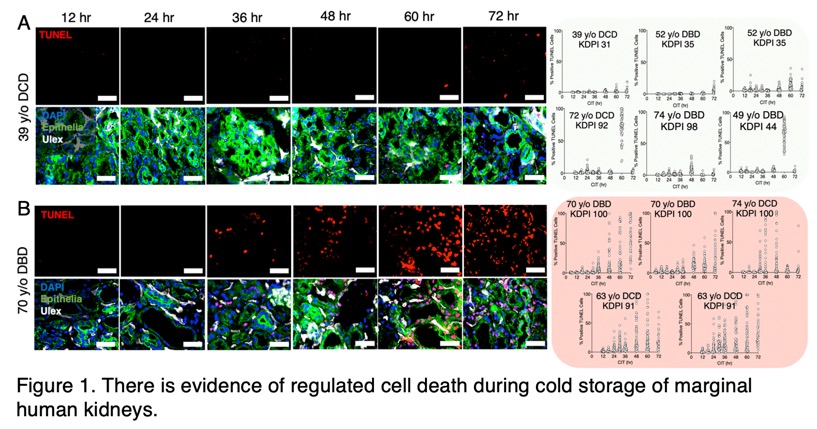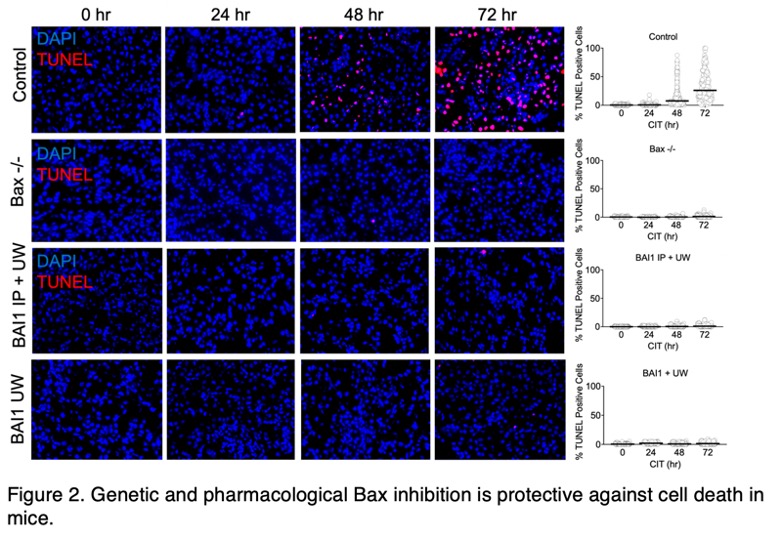Regulation of Cell Death During Cold Preservation of Marginal Human Kidneys
1Surgery, Yale School of Medicine, New Haven, CT, 2Albert Einstein College of Medicine, Bronx, NY, 3Surgery, University of Cambridge, Cambridge, United Kingdom, 4Immunology, Yale School of Medicine, New Haven, CT, 5Albert Einstein College of Medicine, Bronx, NM
Meeting: 2022 American Transplant Congress
Abstract number: 950
Keywords: Organ Selection/Allocation, Preservation, Preservation solutions
Topic: Basic Science » Basic Science » 15 - Machine Perfusion and Organ Rehabililtation - Basic
Session Information
Session Name: Machine Perfusion and Organ Rehabilitation - Basic
Session Type: Poster Abstract
Date: Sunday, June 5, 2022
Session Time: 7:00pm-8:00pm
 Presentation Time: 7:00pm-8:00pm
Presentation Time: 7:00pm-8:00pm
Location: Hynes Halls C & D
*Purpose: Each year thousands of kidneys from marginal donors are discarded due to an increased sensitivity to injury during cold storage and consequently a high risk of poor transplant outcomes. However, the basis of this injury is unclear and as a result we lack appropriate strategies to properly preserve these organs. We hypothesize that marginal kidneys undergo multiple modes of regulated cell death during cold storage that contribute to poor outcomes upon transplantation.
*Methods: To better appreciate how kidneys respond to cold ischemia, we biopsied a series of eleven human kidneys at times from 12 to 72 hours of cold storage and quantified cell death by means of TUNEL staining.
*Results: We found that kidneys from older, marginal donors had significantly more cell death visualized via TUNEL staining (Figure 1B) than younger donors in this series (Figure 1A). Cell death increased over time and became apparent in marginal donors between 30-36 hours of cold storage (Figure 1B). We also found that kidneys from wild type adult mice exhibit the same cell death phenotype observed in humans (Figure 2). However, we have seen that Bax knockout or Bax inhibition with BAI1 at time of recovery completely abrogates this effect in mice (Figure 2). Preliminary data also suggest that Bax inhibition may be effective at reducing cell death in human kidneys.
*Conclusions: Together, these data suggest that cell death throughout the course of cold storage, is more extensive in marginal kidneys, and can be reduced by pharmacological intervention. We speculate that inhibition of cell death may enable better preservation of marginal kidneys and ultimately make more transplants possible.
To cite this abstract in AMA style:
DiRito JR, Chickering G, Langford J, Stern D, Qin D, Hosgood S, Nicholson M, Pober J, Gavathiotis E, Kitsis R, Tietjen G. Regulation of Cell Death During Cold Preservation of Marginal Human Kidneys [abstract]. Am J Transplant. 2022; 22 (suppl 3). https://atcmeetingabstracts.com/abstract/regulation-of-cell-death-during-cold-preservation-of-marginal-human-kidneys/. Accessed January 3, 2026.« Back to 2022 American Transplant Congress


